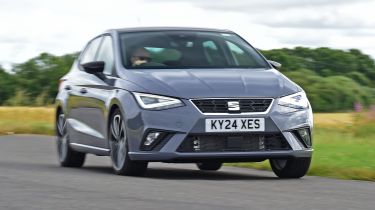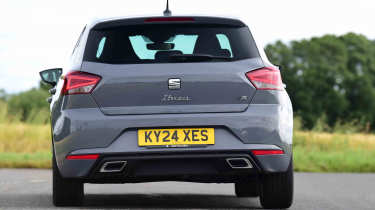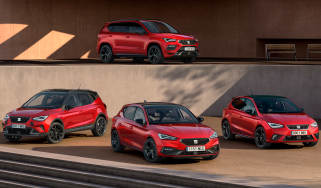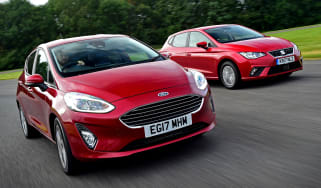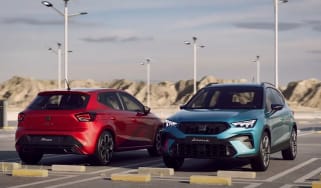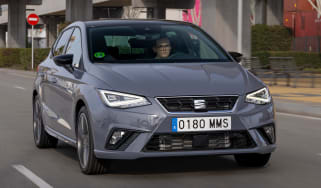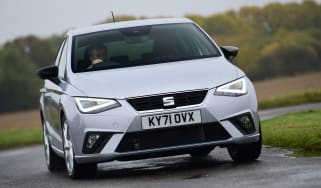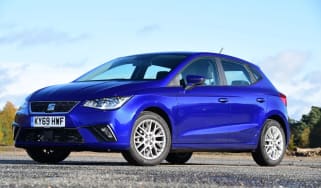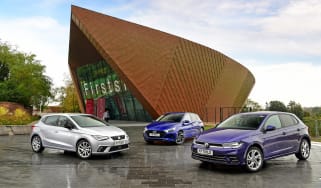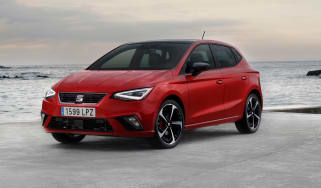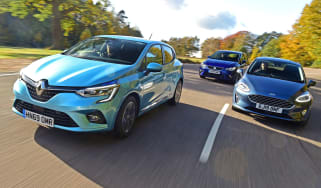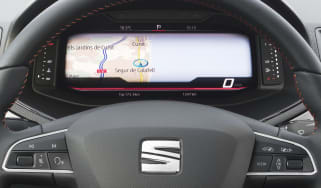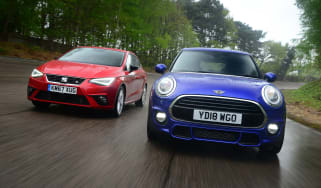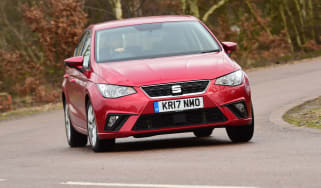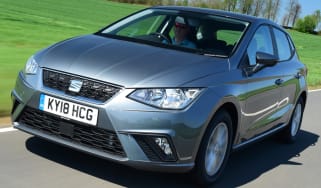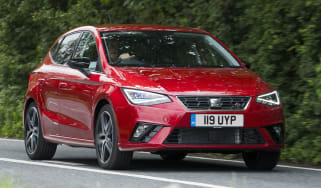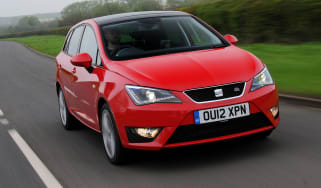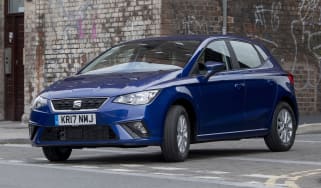SEAT Ibiza review
The SEAT Ibiza includes great on-board tech and still sets a high standard in the supermini class

In keeping with the brand’s image, the latest SEAT Ibiza has the perception of Volkswagen-like build quality and technology, coupled with some Spanish flair. The Ibiza sits as the exotic cousin of the VW Polo, and remains a solid offering in the ever-competitive supermini sector because it’s comfortable, is decent to drive, and surprisingly spacious inside.
In many ways, the Ibiza feels like a shrunken Leon (akin to how the VW Polo feels like a smaller VW Golf these days). A facelift in 2021 addressed some of the previous complaints of scratchy interior plastics and cheap-feeling cabin materials. This, along with a raft of high-end on-board tech and reasonable pricing, helps make the Ibiza a tempting proposition.
Despite its longevity (the Ibiza celebrated its 40th anniversary in 2024), the future of SEAT’s supermini has been called into question recently by VW Group boss Thomas Schäfer, although a facelift of the model should launch in 2025.
About the SEAT Ibiza
It used to sit in the shadow of rivals, but the latest SEAT Ibiza is easily one of the best superminis for sale in the UK today. It was the first small car to use the VW Group’s MQB platform, and as a result it benefits from a raft of cutting-edge tech that you would normally find on larger models.
As with past models, the Ibiza is a sporty choice in the supermini class, even if you don't choose the racy FR or FR Sport models. The handling is sharp, but not at the expense of comfort, while increased dimensions help the Ibiza to be one of the most spacious cars in the class, too. SEAT introduced a refreshed model range in late 2021, which included minor styling tweaks and a much-improved interior with new on-board tech and smarter cabin trim.
Used - available now

2021 Seat
Ibiza
6,166 milesAutomaticPetrol1.0L
Cash £13,700
2024 Seat
Ibiza
8,815 milesAutomaticPetrol1.0L
Cash £17,000
2021 Seat
Ibiza
44,207 milesManualPetrol1.0L
Cash £10,500
2021 Seat
Ibiza
50,217 milesManualPetrol1.0L
Cash £9,000Following the demise of the Ford Fiesta, the Ibiza does battle with the Renault Clio for the honour of being the most entertaining supermini currently on sale, while cars such as the Mazda 2 and Peugeot 208 play the sporty card. Elsewhere, the VW Polo and Citroen C3 are quality alternatives, and the Skoda Fabia, Vauxhall Corsa and Honda Jazz all offer great ability, along with the reliable Hyundai i20 and Toyota Yaris.
All SEAT Ibizas are five-door hatchbacks, with prices starting from a shade under £20,000 – roughly £1,000 less than its VW Polo cousin. With SE being the entry point to the range, there is no basic model in the line-up. All cars get alloy wheels, a touchscreen DAB radio with smartphone connectivity, metallic paint and a suite of modern safety kit as standard.
The sportier-styled FR adds LED headlights, sat-nav, 17-inch alloy wheels, a drive-mode selector and dual-zone climate control. Upgrading from FR to FR Sport results in 18-inch wheels, a digital cockpit, suede-effect upholstery and tinted rear windows. SEAT has also introduced XCellence and XCellence Lux, which add parking sensors and different exterior design.
The Anniversary Limited Edition is the most expensive version of the Ibiza, and was introduced in 2024. Setting it apart from the rest of the range is the panoramic roof, a keyless go system, an uprated sound system, a 10-inch digital driver’s display, cruise control and 18-inch wheels.
SEAT decided not to include a rapid Cupra Ibiza hot hatchback with the current-generation model, and while a punchy 1.5 TSI turbo petrol engine was offered at launch, the current powerplant range now comprises only a 1.0-litre TSI petrol engine with either 94bhp or 114bhp – the latter rising from the earlier models’ 108bhp. The 79bhp 1.0 MPI is no longer available from new.
All cars are front-wheel drive, with the lower-powered model featuring a five-speed manual gearbox. The more powerful TSI has a six-speed 'box, and it can also be had with the slick-shifting seven-speed DSG automatic.
Frequently Asked Questions
Used and nearly new SEAT Ibizas
The original SEAT Ibiza made its debut in 1984 and was the Spanish firm’s first attempt at a homegrown supermini. Up until this point the brand had effectively produced rebadged Fiat models, largely for its home market. Originally a three-door hatch it later spawned a more versatile five-door variant.
Since then there have been four more generations of Ibiza, each aiming to combine a dash of Latin design flair, with fun-to-drive dynamics and value for money pricing. From the second generation on, the supermini shared its underpinnings and engine with other models from the VW Group, which bought SEAT outright in 1990.
SEAT Ibiza Mk5: 2017 to present
The most recent Ibiza is the best yet, and the first to be a true supermini benchmark. Based on the same platform as the current VW Polo, it mixes a refined and grown-up driving experience with typically eye-catching looks and the latest tech. Available only as a five-door, it’s a surprisingly roomy and versatile small car that can easily double as family transport. The rapid Cupra models have been dropped from the range, but the sporty FR models offer warm hatch pace and engaging dynamics.

SEAT Ibiza MK4: 2008 to 2017
SEAT pulled out the stops on the style for the fourth generation machine, which was one of the most distinctive looking superminis when it debuted in 2008. In fact, despite being in production for the best part of a decade it only ever got the most minor of facelifts over the years. It was good to drive thanks to a firm suspension set-up that prioritized sharp handling over comfort, while the hot Cupra models offered lots of performance for the cash. Yet a lack of overall quality and refinement compared to similar era rivals meant the SEAT was rarely in contention for class honours. You can read our full SEAT Ibiza Mk4 buyer’s guide here. Read the full review...
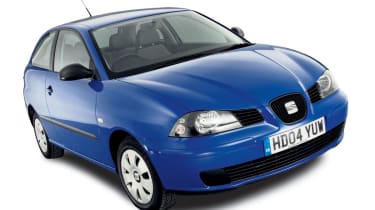
SEAT Ibiza Mk3: 2002 to 2008
The first Ibiza to set the stylish and sporty tones for following models, the third generation model was penned by former Alfa Romeo designer Walter da Silva. Like it’s predecessor it was sportier to drive than many of its rivals, while once again there were hot Cupra versions, including a muscular diesel. This was also the last version of the Ibiza to include a four-door saloon Cordoba version in its line-up. Read the full review...
Older SEAT Ibiza models
The first generation Ibiza was launched in 1984 and was one of the first SEAT models not to be a re-badged version of an older Fiat. While it was loosely based on the Italian firm’s Ritmo family hatch, the three-door Ibiza was styled by Italdesign and used engines that had been massaged by Porsche (most cars had proud ‘System Porsche’ badges applied). Quality was a bit hit and miss, but the SEAT looked good and drove well, especially compared to budget rivals from Skoda and Lada. It’s popularity was boosted by a five-door version, but the Malaga four-door saloon was a slower seller.
However, it was the second generation model that made SEAT a household name, as it was the first model to be fully developed under the firm’s new owners VW. Based on an all-new platform that would go on to underpin the third generation VW Polo, the Ibiza was a much more grown-up and sophisticated car than its predecessor. It was bigger too, with a more practical interior that had a much more upmarket feel. This Mk2 machine also debuted hot GTi and Cupra versions, which effectively used 1.8 and 2.0-litre engines (both 8 and 16-valve) and suspension from the Golf GTi. The SEAT’s appeal was further broadened by the fact you could get a wide range of body styles, including three and five-door hatchbacks, a four-door saloon and even a versatile estate.

